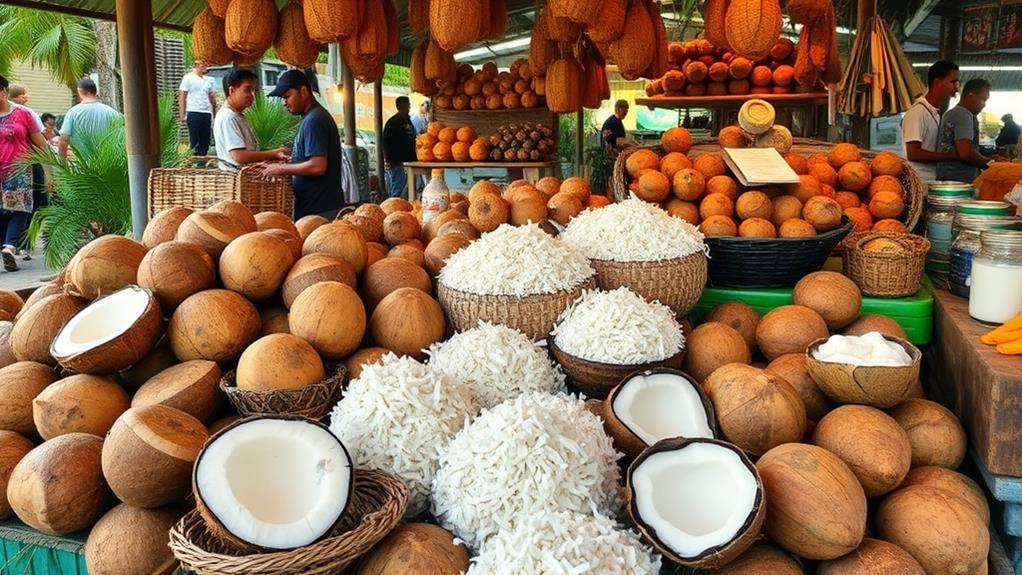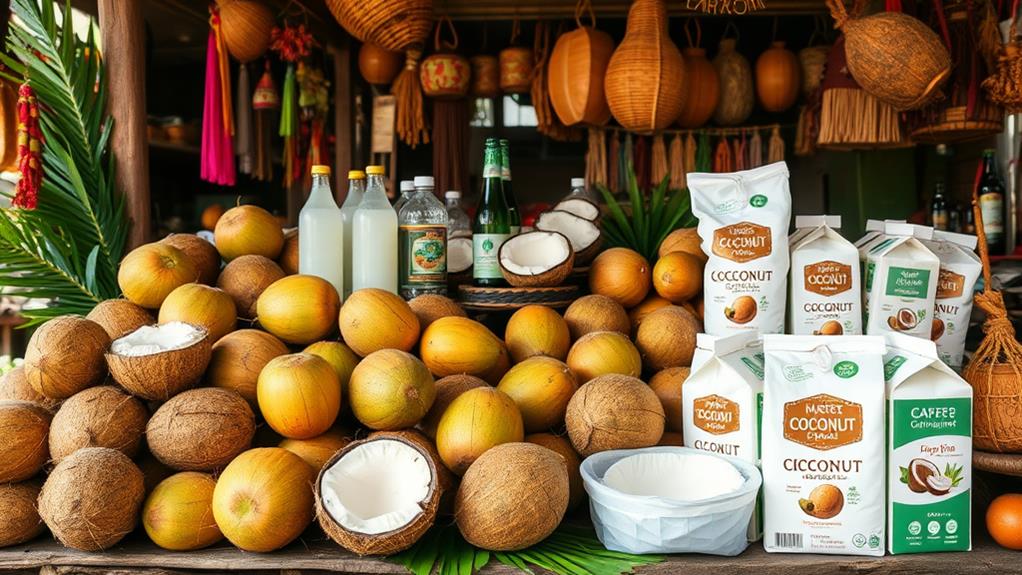The coconut industry is growing rapidly, with the global market projected to reach USD 38.58 billion by 2030, expanding at a rate of 8.4% annually.
This growth is mainly due to the rising demand for healthier products, particularly coconut oil and coconut water, which are the top-selling items.
More than 62% of the industry's revenue comes from cosmetics, thanks to the beneficial antioxidant properties of coconut. Additionally, the use of coconut in food is increasing, especially as more people seek lactose-free options.
Currently, Asia Pacific leads the market, but Europe is growing quickly, offering new chances for businesses.
As people become more concerned about sustainability, the coconut industry is adjusting and hinting at innovations that could shape its future products and trends.
Factors Driving Demand

As more people focus on health and wellness, the demand for coconut products is increasing. This shift towards natural alternatives is part of a larger trend towards healthier living, especially after the COVID-19 pandemic. Many consumers are now seeking out coconut milk and coconut water for their health benefits.
The global coconut products market is expected to grow from USD 20.24 billion in 2022 to USD 38.58 billion by 2030, with an annual growth rate of 8.4%. A key reason for this growth is the rising popularity of coconut oil, which made up 55.1% of the market share in 2022.
People are turning to coconut-based options instead of regular dairy and processed foods because they want products that are healthier and more sustainable.
Coconut products are also used in various industries, including food and cosmetics, showing their versatility.
Market Overview and Projections
The global coconut products market was valued at USD 20.24 billion in 2022 and is expected to grow to USD 38.58 billion by 2030. This growth represents a CAGR of 8.4% from 2023 to 2030. The rise is driven by increased consumer health awareness and a shift towards plant-based diets. In 2023, the market size is estimated to be USD 21.79 billion.
Coconut oil is the leading product, making up 55.1% of the market revenue in 2022. Coconut water is the fastest-growing segment, projected to have a CAGR of 9.4%. The cosmetics sector, which includes skincare and haircare products, holds a significant 62.6% of the market share, showing the popularity of coconut-based items in beauty products.
Regionally, the Asia Pacific is the largest market, capturing over 32% of the share. This is due to the large coconut farms in Indonesia and the Philippines.
As demand for coconut products increases, it's essential to promote sustainable farming practices to support the industry's future. Understanding these trends helps stakeholders succeed in the coconut products market.
Product Segmentation Insights

The coconut products market shows important trends in product segmentation that influence consumer choices and market growth. Coconut oil was the leading product in 2022, holding a revenue share of 55.1%. This is due to its many uses in cooking and health benefits, making it popular among many people.
Coconut water is the fastest-growing segment, with a projected compound annual growth rate (CAGR) of 9.4%. Its rise is because of its health advantages and its increasing use as a natural sports drink.
Other important segments include coconut milk and cream, which are preferred for dairy-free recipes, and various coconut snacks and desserts.
In the cosmetics industry, coconut products made up 62.6% of the market share in 2022. This highlights the common use of coconut oil and milk in skincare and haircare items because of their beneficial properties.
As packaging improves, there will likely be more demand for both food and personal care products, shaping the future of the coconut market.
Applications and Market Trends
Coconut products are popular in many areas because they meet changing consumer needs. In 2022, the cosmetics segment was the largest, holding 62.6% of the market share. This is mainly because coconut oil and milk are known for their antioxidant properties, which are beneficial for skin and hair care. Consumers prefer natural ingredients, driving the trend towards organic and non-GMO products.
The food and beverage sector is also growing, with a projected CAGR of 9.2%. This growth is due to the increasing demand for lactose-free options and natural alternatives. Notably, coconut water is the fastest-growing part of this market, with an expected CAGR of 9.4%. More people are looking for healthier sports drink alternatives, making coconut water a popular choice.
Coconut products can be used in cooking, baking, and health supplements, which makes them appealing to many consumers.
Keeping an eye on these trends is important for businesses to take advantage of growth opportunities and meet the needs of health-conscious customers.
Regional Insights

Regional differences significantly shape the coconut products market. Understanding these variations is important for knowing the market size and potential. In 2022, the Asia Pacific region led the market with 32% of the global share, mainly due to large coconut plantations in countries like Indonesia, the Philippines, and India.
Europe is expected to grow the fastest, with a compound annual growth rate (CAGR) of 10.5%. This growth is driven by the increasing popularity of products like coconut water and coconut milk.
Here's a summary of the regional insights:
| Region | Market Share (2022) | Growth Rate (CAGR) |
|---|---|---|
| Asia Pacific | 32% | 6.0% |
| Europe | 20% | 10.5% |
| North America | 15% | 8.0% |
| Latin America | 10% | 7.0% |
| Other Regions | 23% | 5.0% |
In North America, the market is growing due to a preference for healthier, plant-based options. In Latin America, urbanization and higher disposable incomes are driving demand for coconut products. Each region has unique consumer preferences that greatly impact the coconut products market.
Challenges and Opportunities
The coconut industry faces challenges that could limit its growth. Disease management and supply chain issues are significant problems that affect production and distribution. If these problems aren't solved, the industry might struggle to meet the increasing global demand for coconut products.
On the other hand, there are also opportunities for growth in the coconut market. New products, like energy bars and non-dairy cheeses, are being created to meet changing consumer tastes.
Also, technological advancements are improving production methods, which leads to better quality products and lower costs in processing coconuts.
The global coconut market is expected to double in size by 2030. This growth presents investment opportunities for manufacturers and suppliers.
Countries in Asia-Pacific and Latin America are seeing a rise in demand for coconut products due to urbanization and higher disposable incomes.
It's important for businesses to position themselves well to take advantage of these trends. Balancing the challenges and seizing the opportunities will be vital for success in the coconut industry.
Sustainable Practices in Production

The coconut industry is changing because of eco-conscious consumers who want sustainable practices. This change is important for both the environment and meeting what consumers want. Many companies now focus on sustainable farming and organic methods to ensure they can keep producing coconuts for the future.
Soil health is a key part of organic farming. It helps improve the soil and uses fewer chemicals, which is good for the environment. For example, using compost instead of chemical fertilizers keeps the soil rich and supports plant growth.
Fair trade practices are also important. They make sure that local farmers earn fair wages. This promotes ethical treatment of workers and helps support local economies.
Finally, biodiversity preservation is crucial. Sustainable farming methods protect different plant and animal species, which keeps ecosystems healthy. For instance, planting a variety of crops alongside coconut trees can increase the number of species in the area.
Innovation and Product Development
The coconut industry is adopting sustainable practices that drive innovation and product development. This shift is creating a new range of coconut-based products, such as energy bars, protein powders, and non-dairy cheeses. These items meet the growing demand for plant-based diets and appeal to health-conscious consumers.
Additionally, the rise of coconut-based ice creams and snacks provides tasty yet healthy choices for people. Improved processing techniques enhance the quality and ease of these products, adapting to changing consumer preferences.
This growth is fueled by a focus on health benefits and sustainability, leading to more investment in research and development. Companies are also finding new ways to use the unique flavors and versatility of coconuts.
This strategy aims to attract more customers across different food categories. By emphasizing innovation and product development, the coconut industry isn't only meeting current market needs but also preparing for future growth.
How Are Coconut Products Incorporated Into Antipolo’s Animal Bread Creations?
Antipolo’s talented bakers craft delightful antipolo animal bread by infusing coconut products into their creations. Coconut milk adds a rich texture, while grated coconut enhances flavor and aroma, creating a unique tropical twist. These adorable bread designs pay homage to local ingredients, blending tradition with creativity in every bite.
Competitive Landscape and Key Players

The Asia Pacific region holds over 32% of the coconut products market share as of 2022. This area is significant due to major exporters like the Philippines and Indonesia. The competition is strong, with companies like Vita Coco, PepsiCo, and Coca-Cola's Zico leading the way. These companies focus on product variety and sustainable practices.
Coconut oil is the most popular product, making up 55.1% of the market share. Coconut water is expected to grow at a rate of 9.4% per year, showing that more people are choosing it.
Other brands, such as Theppadungporn Coconut and Renuka, are expanding their offerings to include coconut milk and snacks.
Competition is increasing as these companies adopt sustainable sourcing and broaden their product lines to appeal to health-conscious customers. Keeping up with these changes is important for anyone involved in the coconut products market.
Questions and Answers
What Is the Global Market for Coconut Products?
The global market for coconut products is growing rapidly. Coconut sustainability and health benefits are very important to consumers. For example, coconut oil is popular for cooking and skincare, while coconut water is a refreshing drink. Innovations in these products are helping to meet the demand for natural ingredients and eco-friendly practices. The market is expected to reach USD 38.58 billion by 2030.
What Is the Global Trend With Regards to the Demand for Coconuts?
The demand for coconuts is increasing globally. This rise is due to several reasons, including health benefits, eco-friendly farming, and culinary uses. For example, coconuts are popular in health foods because they contain good fats and nutrients. Additionally, many people prefer to buy products from sustainable farms, which has led to more interest in coconut farming. Finally, coconuts are used in many recipes, from smoothies to desserts, making them a common ingredient in kitchens worldwide. Overall, the trend indicates a stronger market for coconuts as consumers look for natural and healthy options.
What Is the Market Trend for Coconuts?
The coconut market trend focuses on sustainable practices. This is due to the health benefits of coconuts, such as being rich in nutrients and healthy fats. As more people seek healthier food options, the demand for coconut products like coconut water, oil, and milk is increasing. Businesses are responding by expanding their coconut product lines. For example, many companies are now offering organic coconut products that appeal to health-conscious consumers. Overall, the coconut market is growing because of rising consumer interest and the push for sustainability.
What Is the Global Distribution of Coconut?
Coconut distribution around the world is mainly determined by where coconuts are grown. Coconut cultivation practices play a significant role in this distribution. For instance, countries like Indonesia, the Philippines, and India are among the largest producers due to their suitable climates. However, these regions also deal with challenges from coconut pests, which can harm crops and reduce yields.
To combat these issues, sustainable methods are essential. These practices help maintain production levels and adapt to changing global demands. For example, using organic pesticides or planting resistant coconut varieties can protect against pests. This focus on sustainability not only supports local economies but also ensures a steady supply of coconuts worldwide.